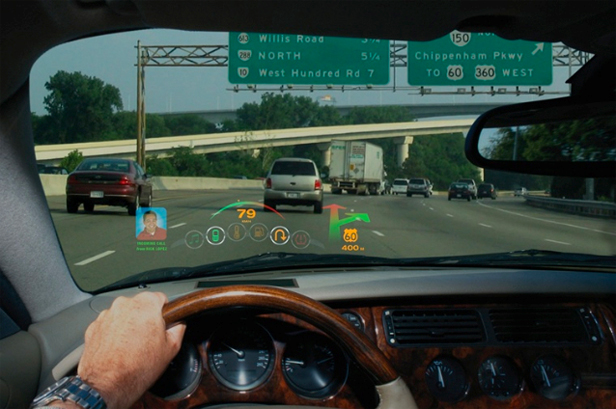Laser System Paints Information on the Road Ahead

Head-up displays, which project visual data onto the windshield and the driver’s view of the road, are debuting in a growing number of car models. But more vibrant, compact, and efficient displays being developed by Microvision, a company based in Redmond, Washington, could help the technology become much more common.
Japan’s Pioneer Corporation plans to release its first head-up display product based on Microvision’s novel technology this year. Major carmakers in Detroit are also planning to integrate the technology into their vehicles by 2016, says Lance Evans, a director of business development at the company. Microvision’s image projector relies on semiconductor lasers and a microscopic mirror.
The company’s head-up display is already in some concept cars but has so far been too costly for commercial models, says Evans. Now, falling prices of green lasers—a significant cost component of the display—should make the technology competitive with conventional displays, he says.
Most existing head-up displays generate images using LCDs. Light-emitting diodes produce light and liquid crystal arrays act as shutters, controlling whether or not light reaches each pixel. This approach drains power, and the images often aren’t bright enough to be visible in daylight. Newer displays use either liquid crystal devices or hundreds of tiny mirrors to reflect light onto each pixel. While more energy efficient, these displays are still not very bright.
Microvision’s system uses a set of three lasers—red, green and blue—and a single, millimeter-wide silicon mirror that tilts on two axes. The lasers put out light at different intensities, and the three colors are mixed to produce the final pixel color. As the lasers shine light on the mirror, it rapidly scans horizontally and vertically, painting the image onto the windshield one pixel at a time. This happens so fast that the image looks static. Evans says that the lasers’ pure, saturated colors result in more vivid images with a higher contrast ratio, so they are visible in daylight. Illuminating one pixel at a time also saves energy. And the use of a single mirror rather than an array makes the device smaller, simpler, and cheaper.
The final cost of Microvision’s product will hinge on the price tag of advanced green lasers. Materials for true green lasers have traditionally been difficult to engineer, so most green lasers contain semiconductors that emit infrared light, which is converted to green using complicated optics. In the past few years, though, half a dozen key players, such as Nichia,Osram Opto Semiconductors, and Soraa, have developed cheaper pure-green lasers. They’re slowly scaling up production, which should lower costs. Evans expects that costs should fall to a tenth of current levels by the end of this year.
“Green lasers alone are $200 each now,” he says. “Car companies are looking at the whole display to be that much.” Microvision’s laser-scanning display technology beats its competitors in terms of image quality, says Krishna Jayaraman, an analyst at Frost & Sullivan.
While other companies are also developing laser-based head-up displays, Microvision was the first to propose the approach and has a technology lead. Chris Chinnock, president of the display market research firm Insight Media, points out that mobile connectivity is on the rise, and drivers need more and more information to be displayed in the least distracting way possible. That means the head-up display market for cars could be on the cusp of significant growth.
Keep Reading
Most Popular
Large language models can do jaw-dropping things. But nobody knows exactly why.
And that's a problem. Figuring it out is one of the biggest scientific puzzles of our time and a crucial step towards controlling more powerful future models.
The problem with plug-in hybrids? Their drivers.
Plug-in hybrids are often sold as a transition to EVs, but new data from Europe shows we’re still underestimating the emissions they produce.
Google DeepMind’s new generative model makes Super Mario–like games from scratch
Genie learns how to control games by watching hours and hours of video. It could help train next-gen robots too.
How scientists traced a mysterious covid case back to six toilets
When wastewater surveillance turns into a hunt for a single infected individual, the ethics get tricky.
Stay connected
Get the latest updates from
MIT Technology Review
Discover special offers, top stories, upcoming events, and more.